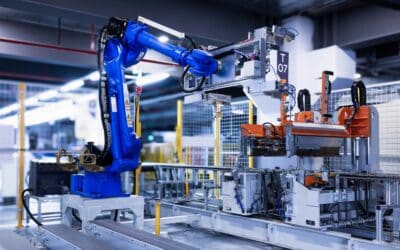Machine vision is retouching in Photoshop? Not at all! Behind industrial machine vision hides an entire field of knowledge around the acquisition and processing of images in an industrial context. It includes both software and hardware to map the entire image process with camera, exposure, data processing and output. In the course of the growing automation and digitalization of production, machine vision is primarily used for robot guidance and quality inspection of workpieces.
Possible applications in machine vision
Machine vision is always worthwhile when one a task is repeated frequently or has a high cycle rate. However, consistent conditions and unambiguous inspection characteristics are absolutely necessary for this. Accuracy, precise comparability, stable and linear results are further requirements.
This standardization also results in the greatest challenge of industrial machine vision. Consequently, commercially available systems usually require a limitation of these degrees of freedom. Moreover, many of them cannot yet be adapted to new situations or even expanded on a modular basis. However, the next generation of high-performance machine vision systems is already in the starting blocks: they can cope with all these parameters better than before.
And that is also necessary. After all, machine vision must be robust and reliable for industrial use. In contrast to academic or military applications, the focus is also on the cost-benefit aspect.
WHY USE A MACHINE VISION SYSTEM NOW?
Machine Vision is always integrated when one or more of the following automated functions are required:
- Position and attitude determination of objects,
- Shape and dimensional inspections,
- surface inspection,
- completeness check,
- barcode, area code or character recognition,
- Reactive robotics.
A complex system that long posed insurmountable challenges
Industrial machine vision has only been around since about 1975, and for a long time it was a neglected field in manufacturing facilities because capturing images involved high demands on digital memory and processing capacity. The increased performance of industrial PCs in the last decade has given this development a massive boost. Accordingly, software now accounts for a not insignificant share of machine vision.
It must be able to process large amounts of data in the shortest possible time: This is because digital images contain a large amount of information, and at high resolution to boot. If machine vision software is to keep pace with the clock rate in production, powerful processors are essential. This is why embedded computers or industrial PCs are usually used. There, incoming image data is then segmented, labeled and classified before the actual evaluation takes place. In this way, the system breaks down the complex image data into machine-readable information.
Better results through greater specialization
Anyone who has ever taken a closer look at their own vacation snapshots understands that it takes more than the push of a button to produce a successful image. This also applies to industrial machine vision. Although there are no artistic demands here, the documentary character of the images requires maximum precision. To meet these demands, numerous sub-areas of image processing and multidisciplinary approaches have developed. In this way, even difficult initial situations should lead to good images. The individual categories today include:
- Camera selection including lenses and sensors,
- Lighting,
- Image and data transfer via frame grabber,
- Shooting situation,
- Industrial PCs,
- Image processing software,
- Mounting and object guidance.
Well-founded knowledge and experience are necessary for a good interaction of these components. It is therefore not uncommon for specialists from different areas or companies to come together for machine vision projects. This is another reason why machine vision meets with little approval from some plant managers: In the past, the complex projects have led to unforeseen challenges on many occasions, even with the most careful planning. New systems can make planning and implementation easier to a certain extent.
Entrepreneurial opportunities through machine vision
Limited degrees of freedom, challenging projects, unpredictable turbulence – why do companies turn to machine vision in the first place?
Their use is based on the growing desire for error-free and cost-effective production. Both globalization and the aging population are leading companies to increasingly automate simple and repetitive tasks. In turn, production workers’ tasks are becoming more exciting and less physically demanding.
New possibilities, more robust systems, falling prices: Machine vision is turning from a problem child into a shooting star. Faster innovation cycles in optics and computer performance as well as falling prices are leading to high-quality solutions for companies. These developments put industrial imaging in a position to meet rising quality demands in the future.



